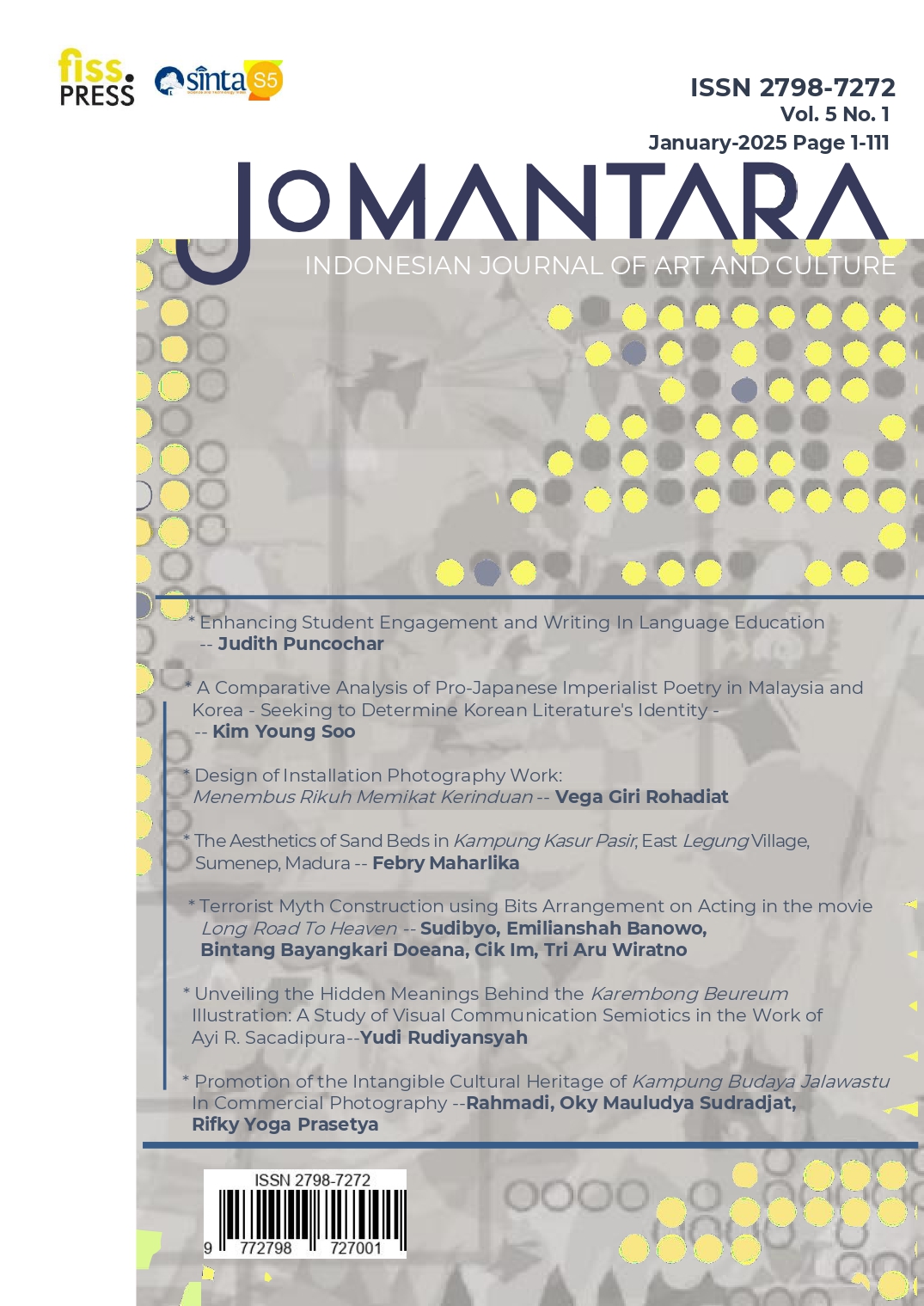The Aesthetics of Sand Beds in Kampung Kasur Pasir, East Legung Village, Sumenep, Madura
DOI:
https://doi.org/10.23969/jijac.v5i1.20344Abstract
This study examines the aesthetic value of sand beds in Kampung Kasur Pasir,East Legung Village, Sumenep, Madura, by comparing the aesthetic perspectives of the Western and Eastern worlds. Sand beds are a unique cultural phenomenon that blends natural elements with local traditions, creating a rich aesthetic experience for the local community. From a Western perspective, the aesthetics of sand beds can be analyzed through the concept of visual harmony in both form and content. Meanwhile, from an Eastern perspective, sand beds represent spiritual balance and a harmonious relationship between humans, nature, and the Creator. The findings reveal that sand beds serve not only as a place for rest but also as a medium of aesthetic expression that integrates cultural, emotional, and spiritual elements. This multidisciplinary approach highlights how local aesthetic values can contribute significantly to the global understanding of aesthetics. This study aims to enrich the discourse on beauty within the context of local traditions while offering new insights into the interaction between culture and aesthetics from diverse perspectives.
Downloads
References
Azhar, F. (2016). Studi Penggunaan Pasir dalam Kehidupan Masyarakat Pesisir Desa Legung Timur, Kabupaten Sumenep, Madura. Universitas Brawijaya.
Creswell, J. W. (2019). Research Design : Pendekatan Metode Kualitatif,Kuantitatif,dan Campuran (4th ed.). Pustaka Pelajar.
Dalela, A. (2008). Vedic Creationism: Vedic Theories of Creation and Their Relation to Science. iuniverse.Inc.
Faiq, M. H. (2019). Dipeluk Kasur Pasir di Legung Timur. Kompas.Id. https://www.kompas.id/baca/ga ya-hidup/2019/12/15/dipeluk- kasur-pasir-di-legung-timur
Jaya CK, I. G. N. A. (2019). BENTUK WAYANG BHUTASIU DI ATAS DAUN LONTAR.
Magdalena, E., Natalia, D., Pranata, A., & Wijaya, N. J. (2022). Filsafat dan Estetika Menurut Arthur Schopenhauer. Clef : Jurnal Musik Dan Pendidikan Musik, 3(2), 61–77.https://doi.org/10.51667/cjmpm. v3i2.1111
Marijo, M.Okta Dwi Sastra F, M., Jazuli, M., & Mari’i. (2023). Estetika Timur dalam Teater Tradisional Kemidi Rudat Lombok. Sitakara :Jurnal Pendidikan Seni & Seni Budaya,8(2), 172–182.
Pangestutiani, Y., & Habibah, A. N. (2022). Pragmatisme John Dewey dan Korelasinya Terhadap Ajaran Agama Islam. Jurnal Ilmiah Spiritualis: Jurnal Pemikiran Islam Dan Tasawuf, 8(1), 108–123. https://doi.org/10.53429/spiritua lis.v8i1.380
Patriansah, M., & Prasetya, D. (2021). Estetika Monroe Bardsley, Sebuah Pendekatan Analisis Interpretasi Terhadap Lukisan Yunis Muler. Imajinasi: Jurnal Seni, 15(2), 41–48.
Satria, K. B. (2020). Significcant Form Sebagai Ide Penciptaan Karya Seni Lukis. http://digilib.isi.ac.id/id/eprint/7 065%0Ahttp://digilib.isi.ac.id/70 65/4/JURNAL.pdf
Sumardjo, J. (2000). Filsafat Seni. ITB. Sumardjo, J. (2010). Estetika Paradoks (E. Caturwati (ed.); Revisi). Sunan Ambu Press.
Surajiyo. (2015). Keindahan Seni Dalam Perspektif Filsafat. Jurnal Desain, 02(03), 157–168.
Yusuf, M., & Anggraini, R. D. (2024). Estetika Barat dan TImur. Cerdika, Jurnal Ilmiah Indonesia, 4(6), 423–428.
Downloads
Published
Issue
Section
License
Copyright (c) 2025 Publisher Universitas Pasundan

This work is licensed under a Creative Commons Attribution-NonCommercial 4.0 International License.
Copyright Notice

This work is licensed under a Creative Commons Attribution 4.0 International License.









